 |
||
|
||
| ||
Wireless technologies have been attracting users not for their speed but mainly for their mobility and simplicity of installation. Today there are several such technologies. One of the wireless communication standards was burn on the base of Ehetrnet and DECT technologies. Initially it has quite low speed - the first products (April 2000) provided only 0.8 or 1.6 Mbit/sec. However in August 2000 FCC agreed upon expanding HomeRF bandwidth, what allowed to increase speed considerably - up to 10 Mbit/sec and to become a tough alternative to IEEE 802.11b. In December 2000 HomeRF 2.0 standard was introduced. It differs from the 1.0 version in the following:
Today a lot of companies produce HomeRF 1.0 based products. Among them are Proxim, Cayman, Compaq, Motorola, SimpleDevices, Siemens, iRobot. Products include such as network adapters, bridges, wireless modems, audio equipment, phones, PDA, clocks and even an operated robot! HomeRF 2.0 based products are expected to be compatible with the previous generation. Intel has released adapters for organization a home network on Home FR 1.0 standard. 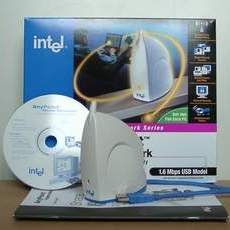 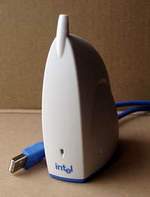 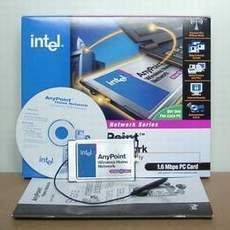  InstallationThe complete set contains a device, a manual and a CD with drivers and programs. First you should read a big colorful poster named "Read This First" and a couple of lines from the section "SetUp the AnyPoint Home Network" in the manual and make sure that your configuration suits. The CD contains:
If you don't have a CD-ROM drive there is a possibility to create a diskette with a driver. The CD also contains some files from Windows 95-98SE distributives which can be handy for installation of adapters. Now let's take a box of an adapter with a USB cable (180 cm). On the front panel of the device there is only one LED: green light means that the device is on, orange blinking means data transmission/receipt. The device isn't equipped with a USB hub that is why it must be it the end of USB chain. Power consumption from USB bus constitutes 500 mA, what is a limiting point for the majority of USB ports in a PC. Connection process... Windows finds HomeRF adapter, we ask to look for its drivers on the CD, but it turns out that they are in the disc's root :( The second attempt with \DRIVERS directory was more successful, the drivers were found and installed. While installation you need to key in a network code. It is 8 figures (from 0 to 7), which must be the same on all PCs of the wireless network. The aim of the code is to protect networks from illegal access and separation of networks working in one space. Since it's our first installation let's take any figures, for example 0123-4567. Despite the fact that the device is USB, and therefore Plug&Play, you should reboot the system after installation. It's typical for Windows 9x when you are changing network settings, and especially adding a new adapter. After installation of the adapter the system boots 3 minutes longer. Apparently it's connected with initialization of the adapter, since in case of check-up of PnP technology deletion of the adapter didn't cause any problems and the second installation caused hanging of a PC for several minutes. Another reason can be an overload of network settings, in our PC we had also a usual netcard and a modem. After rebooting we saw a new network adapter in a control panel (in the network adapters section, not in USB part). Plus, Intel AnyPoint Home Network Wireless API Protocol was installed, as well as TCP/IP and NetBEUI were auto installed for the new adapter. By the way, apart from a driver no additional programs are automatically installed. The next step was an installation of an analog adapter on the second PC. It turned out that there are drivers only for Windows 98 and Windows ME, and on the second PC we had Winsows 2000. So, I had to install Windows ME there. There were also no difficulties with installation of an adapter under this OS. There are two variants of system installation. The first one is to install only drivers for adapters, then protocols and other stuff. The device operates as a usual network adapter, that is why you can use all protocols and services in the OS, including a program (integrated in Windows 98) on combined usage of the Internet by computers of the local network. The first my experience was the following. Having installed TCP/IP I started Quake3 on a new network. All worked perfectly. Having measured read speed of the HDD on the network I received 50 KBytes/sec (in an analog configuration on the 10BaseT network it is 800 KBytes/sec). And today it's too little. Windows 98 distributive, for example, will be being downloaded 40 minutes! This speed is enough for modern audio multimedia files to be viewed on the net (e.g. 128 Kbit MP3 = 16 KBytes/sec). But quality video is hard to receive. The second variant is usage of software from Intel AnyPoint Home Network set. First let's install AnyPoint Connectivity Suite version 2.0. This set 8 MBytes in size consists of two parts - Essential Network Software and Internet Sharing Software. The first one is always installed, the second - whether you like. So, ESS. This program consists of Sharing and Mapping Software and Technical Support Ulitity. After rebooting there rise questions :). The Sharing and Mapping Software program controls the network and suggests you connect new resources if they appear on the net (discs, printers). And it makes it automatically. For example, after the first rebooting on the second PC I have received a reference to another PC on the desktop and a lot of network discs. Later, having started the program you can enable general access to your discs and printers via it, as well as connect others: 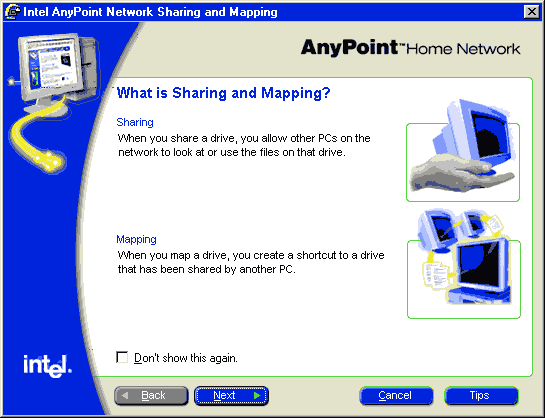 The second program from Essential Network Software is Intel AnyPoint NetworkTechnical Support Utility  It carries out diagnostics of an adapter and checks connection quality. You can also change a network code with it. But there is another way to change it - after installation of the software the Control Panel gets an icon of Wireless Control Panel. This program has only two functions - check up of connection quality and changing of a network code. ISS is installed in two configurations - server and client. As you can see, ISS server in installed on a PC which has Internet access via a modem, and you should install ISS client on others. Apart from combined Internet access function, ISS helps to adjust TCP/IP protocol on all PCs of the wireless network. ISS has no considerable difference from Internet Sharing included in Windows 98. If all PCs are working under Windows, then it's more interesting to install the Intel program; if there are PCs under other OSs then I'd recommend to use the Microsoft program. It's not only web browser programs that work via ISS, but also email, telnet, ftp. A number is dialed automatically, on receiving a request for the Internet access. Connection can be break from the server or any PC (this mode can be switched off). There is possibility to use not only modem connection, but also a cable and DSL connection. The only problem is that in this case a home 1.6 Mbit/sec network can restrain Internet access speed :) 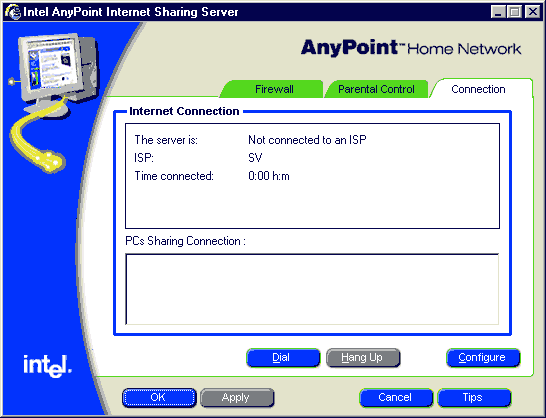 An integrated Firewall is based on BlackICE technology from NetworkICE. It protects a PC, connected to the Internet, from attacks. Since the maximum protection often contradicts to some Internet technologies, there are four levels of access restriction. 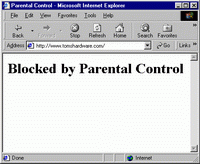 There is a possibility to block access to Internet sites. These parameters are set separately for each PC. There are three modes:
When accessing a prohibited site a user will see a warning. InterCom is a voice communication program. The program allows to transfer voice from a mic to other PCs of the network. It's possible to enable duplex or half-duplex mode. For this purpose you have to install a complete software set from Intel AnyPoint to a PC. Quality of voice transmission by a program is not very good, and there is no possibility to adjust an audio codec manually.  On the Intel's site you can download beta version of the program which provides connection of wired and wireless networks. If on a PC there are two netcards (one of which is of Intel AnyPoint series) the AnyPoint Software Bridge program implement bridge functions. The first problem I faced when installing this software is regional settings. The whole process often caused the system to hang, required rebooting all the time etc. As a result I decided to take off the earlier installed software and start from the very beginning. It worked. But for the fact that the program warned that an old version of NDIS.VXD file was installed (a part of network drivers), but it still suggested going further. At the end it again blamed this file. So, I downloaded the file from the Microsoft's site. The PC on which I installed the bridge saw no one in the network. And I had to reinstall the client. At last I achieved a positive result: three PCs, one with a usual netcard, the second with a radio card and the third had the both cards, worked as being in one segment. Speed decreased from 50 KBytes/sec to 40 KBytes/s. Well, of course you shouldn't expect perfect operation from a beta version but I hope for an official AnyPoint Software Bridge version to be launched soon. Practical measurement of distances was complicated by lack of diagnostic software which shows signal quality in a speaker. The total result is the following - within 20 meters everything worked at max speed through three walls and a working PC. Official limit is 50 meters indoors. As for a number of computers simultaneously working with AnyPoint Home RF Network, the HomeRF 1.0 specification gives 10. Position of antennae influences the speed as well. Wrong position can decrease speed by 20%. The second variant of the card is for PCMCIA bus, it is intended for notebooks (though the majority of modern mobile PCs have a USB port). It differs from USB variant in an external antenna. It seems that production adapters with PCI bus is not planned. Though such variant is preferable for desktop PCs. USB advantages can turn out to be downsides, for example: there is no need for external power supply - consumed current of this adapter will not allow to connect other devices to this USB port; easy PnP installation without opening the PC case - additional cables and necessity in place for installation of an adapter. An the end of testing I found out that Intel has drivers for Intel AnyPoint Wireless Home Network and for Windows 2000. I have tried them and found no complications. It means that the list of compatible operating systems includes Windows 2000 Pro. ConclusionOn the whole the product made a positive impression on me - a little light box, on a long USB cable, which doesn't require additional power supply and allows to connect PCs into a network. On the one hand, it can be used as a netcard, for connection of two networks for example. And for inexperienced users the Intel AnyPoint Wireless Home Network can help to organize a common Internet access. With extension of a list of products with HomeRF technology support, a range of adapters' application can broaden - home equipment control, listenning to music and radio from a PC with wireless headphones on, data synchronization with PDA etc. Adapters implements its direct function - organization of a home network - perfectly, and lack of cables and easy installation on USB bus helps it a lot. This product is not an alternative to usual wired
networks. First, speed is not enough for a modern network with its
huge files and "thick" multimedia streams (the situation will change
when HomeRF 2.0 products appear). The second problem can be a restricted
distance of radio card operation.
Write a comment below. No registration needed!
|
Platform · Video · Multimedia · Mobile · Other || About us & Privacy policy · Twitter · Facebook Copyright © Byrds Research & Publishing, Ltd., 1997–2011. All rights reserved. |